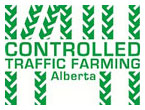Agronomist Notes
Hello Reader
Pea and malt barley dust fills the air, my nose and my ears, as harvest is in full swing after a short rain delay last week. The start of winter wheat harvest has also begun along with early sown spring wheat. Commercial truckers are having a hard time keeping up with short hours of operation at the elevators combined with hauling 2013 carryover grain and the start of the new crop.In this week’s issue of Beyond Agronomy News we’ll look at the use of GreenSeeker technology to apply desiccants on peas for a quick ROI. Next, I’ll feature a very simple and effective inter-row band sprayer from the Mallee region of Australia. Last, it’s time to review some tax strategies to ponder before we get right into harvest. We’ll finish with technical grain market news.
September break for Beyond Agronomy News. I take two weeks off during September each year for our own harvest and to recharge the mind after 34 weeks of writing. The newsletter will be back on the 16th of September. Until then have a safe harvest and for those on the other side of the planet, enjoy the spring weather!

Photo: Harvesting Saffron yellow field peas in our CTF system, Tuesday near Munson, AB. We're thankful for the tram lines and seeding into tall wheat stubble. The crop is dream to harvest, even after 7 inches of rain this month.
Harvest Progress
(Calgary to Drumheller to Three Hills)Crop Complete
Wheat 0%
Canola 0%
Barley 2%
Peas 30%
Steve's tips and tricks of the week
Follow me on Twitter for in-season updates @BeyondAgronomy
- We harvested standing peas at 4 mph, never touching the reel or moving header height, even after 7 inches of rain this month. Inter-row seeding pulse crops into tall standing stubble is a no brainer.
- The straw is very tough this fall, so make sure you have those choppers fine tuned to cut and spread properly. Take the time to make adjustments.
- Straw is selling for $7 to $12 a bale in the swath. That's pretty cheap compared to the cost of nutrient removal. I only recommend baling when lage volumes of residue create issues the following year.
- 14 day trend calls for cooler weather with intermittant showers and wind. I'd recommend pre-harvest glyphosate on late maturing crops to help facilitate the dry down of straw.
Agronomy
Variable rate desiccation with GreenSeeker technology
We’ve been mapping with our GreenSeeker for the last two years to help us locate variability and begin to understand how to address that variability. Aside from real time variable rate nitrogen, the GreenSeeker is a perfect tool for VR desiccation in pulse crops.Each year we spend big money on expensive desiccants like Diquat (Reglone). They perform very well but at $22.00 a litre it doesn’t take long to rack up a large bill. Pulse crops are notorious for maturing unevenly from differences in soil texture, moisture, slope and topography. A classic example would be mature crops on the south facing slopes and hilltops, brown pods but green stems on the mid slopes and green pods and stems in the low spots or heavy weed pressure. That’s where VR desiccation comes in. Let’s run some quick math on a field of yellow peas we mapped last week.
Steve’s quick math
Reglone is $22.00 per litre. Field is 207 acres.
NDVI Rate of Reglone Acres Cost
0 to .25 0 L/ac 58 $0.00
.26 to .50 0.5 L/ac 96 $1,056.00
.51 to .65 0.9 L/ac 42 $831.00
0.66 to .90 1.1 L/ac 11 $266.20
Flat rate 0.9 L/ac 207 $4.098.60
In this scenario, the cost of VR Reglone with the GreenSeeker is $2,153.20 compared to a flat rate of $4,098.60. That’s a 47% savings in herbicide cost while increasing efficacy. The VR application would see double the product and water volumes in the green, dense areas while backing off in the areas with lighter vegetation that require less. The end result would be a quicker and more even dry down across each field.
Putting it into practice
To vary the water volume by 2x rate from 40 L/ac to 80 L/ac spray specialist Dr. Tom Wolf suggests a 05 Turbo TeeJet nozzle that offers a pressure range of 20 to 80psi. For example, at 15 mph you can apply 40 L/ac of water at 40 psi. At 10 mph you can apply 80 L/ac of water at 70 psi. You will have to sacrifice speed in the green, dense areas but at least you’ll be doing a great job with high water volume and 70 psi of pressure to really drive that water into the canopy for great coverage.
When it comes to VR desiccants, mapping with the GreenSeeker has revealed a great opportunity for us to improve dry down of field peas while saving on inputs. We still need to do more work on cross referencing NDVI values versus crop maturity and visual appearance so we know what NDVI ranges to apply specific rates of desiccant. Once we get that dialed in, we’ll be away. Until then, I can’t wait to put this into practice at home and with clients in 2015. SL
Image source: S. Larocque
Inter-row band spraying
A simple design fights herbicide resistance
I came across a great innovation on Twitter this week from Leigh Bryan who farms in the Mallee region of Victoria, Australia. Leigh built a mechanical shroud sprayer that uses crop rows to physically guide the shrouds rather than sensors, paddles or hydraulic hitches. I’ve featured similar technology like the CropStalker in previous issues, which uses cameras and a hydraulic hitch to guide shrouds between the rows. The CropStalker is accurate in young crops while Leigh’s shroud sprayer finds accuracy at later stages of crop growth. Go <here> to find photos of Leigh’s mechanical shroud sprayer. Notes
Leigh modified a pull type sprayer at a cost of $4,000 AUS. The shrouds are mounted on a 50-foot toolbar with 18-inch row spacing. He applies Paraquat with 90 L/ha of water at 65 psi, travelling 15 km/hr and he applies glyphosate with 70 L/ha of water at 32 psi, travelling 15 km/hr. The crop needs to be 2nd node stage or higher. Each shield floats individually and the crop holds them in place
I really appreciate the simplicity of this design. A 40-foot boom using cameras and hydraulic hitches can run up to $90,000 US to guide shrouds accurately. Here we have a 50-foot boom that uses crop rows for guidance and 45-degree brackets to help the shrouds float above soil surface, all for $4,000 AUS. Add the cost of a second hand pull type sprayer and you could look at total cost of $20,000 to replicate this design in Canada.
This design is limited to later spray applications to control the escapes that occur during early herbicide spraying. The weeds that do escape the first herbicide application are the ones that contribute most to herbicide resistance by increasing the weed seed bank in the soil. I look around our countryside at the wild oats, sow thistle, and cleavers sticking above the canopy and can’t help but think when we will be forced to use technology like shroud sprayers to manage herbicide resistance. It’s not as far out as you think, Western Canada. SL
Special thanks to Leigh for sharing his knowledge and photos of his design. He’s a good one to follow on Twitter @leighjbryan
Photo credit: Leigh Bryan
These taxing times
What to do with a good income problem
Thanks to Merle Good for providing the following tax strategies. Merle is a private tax specialist now after retiring as the provincial specialist for Alberta Agriculture.With the cattle market surging and grain income still at profitable levels, it is imperative that your bill to Revenue Canada does not cause you nightmares. For example, if your corporation has net income exceeding the small business deduction of $500,000 your tax rate explodes from 14% to over 30%. A couple of interesting strategies should be reviewed this year.
- Acquisitions of bins through a lease program can result in 5-10 times the write-off compared to a straight purchase.
- Creation of a separate corporation with a different year end can be used to shift income between enterprises in some family farm situations.
- Unincorporated businesses looking to acquire equipment should instead look at leasing equipment in 2014 personally and then roll the equipment into a newly formed company. In 2015 the corporation exercises the purchase option.
- The usual pre-year end deferral of income or pre-payment of crop expenses is critical especially if you are pushed up into the top corporate or personal income tax brackets. Remember there is no longer any income averaging available.
- Look at your RRSP carry forward allowance. Some producers have significant contribution room.
- Pay your spouse a bonus and let her keep the money. This pays huge dividends eventually!! MG
Market News
The charts I use take a short and long term look at whether the market is oversold, neutral or overbought. I use charts as a way to pull the trigger, not to determine the best price.
Canola Nov 14: The long and short term trends are down.

HRS Wheat: Dec 14: The short and long term trends are down.

Corn Dec 13: The short and long term trends are down.

Soybeans: Nov 14: The short and the long term trends are down.

Canadian $: Sept 14: The short and long term trends are down.






